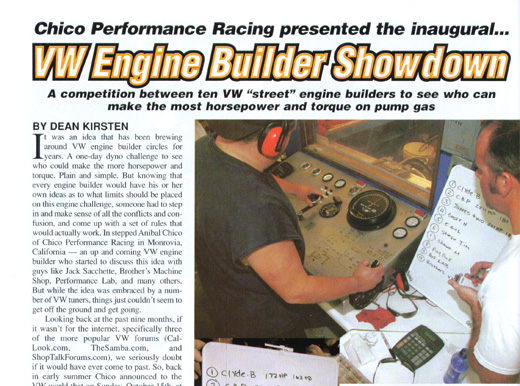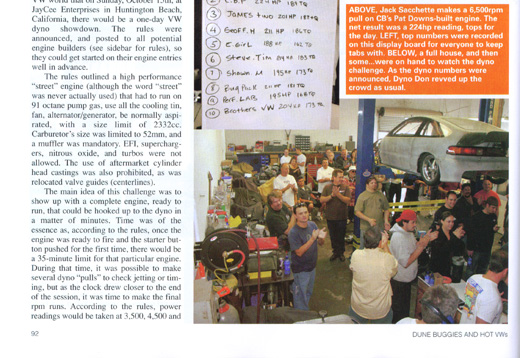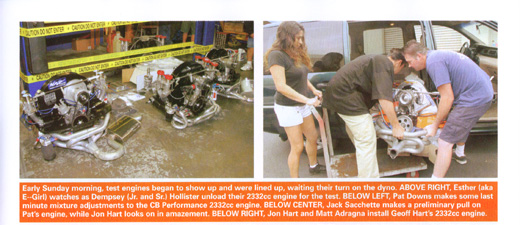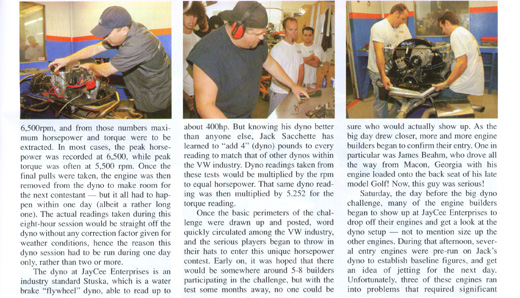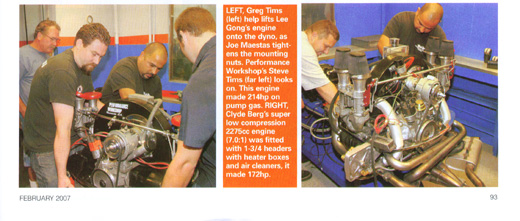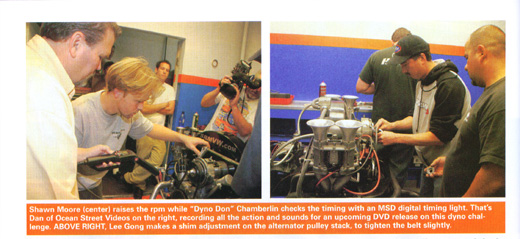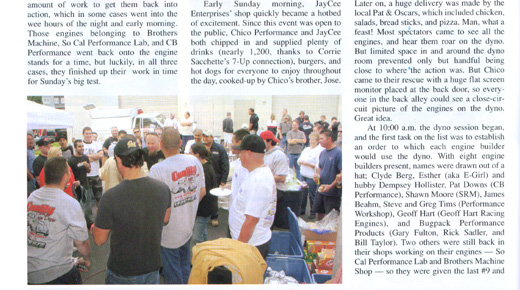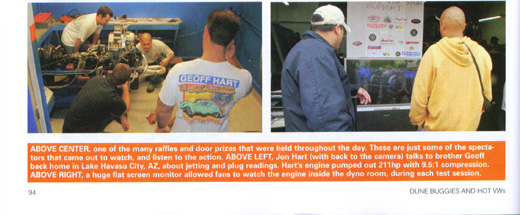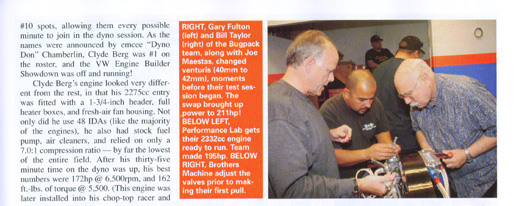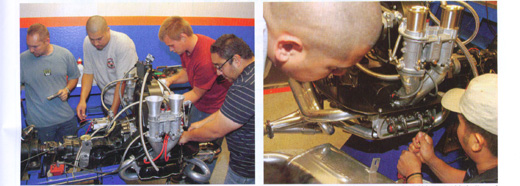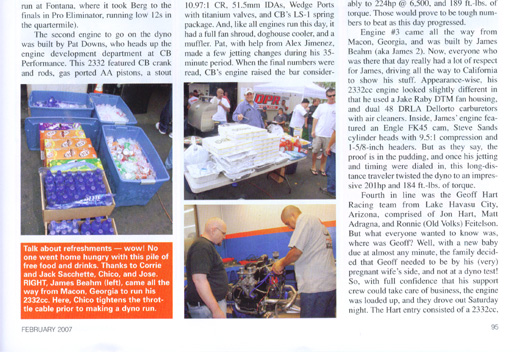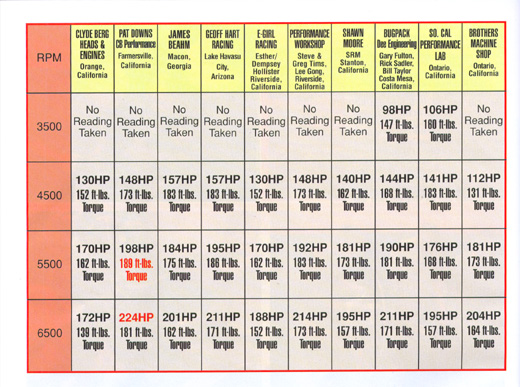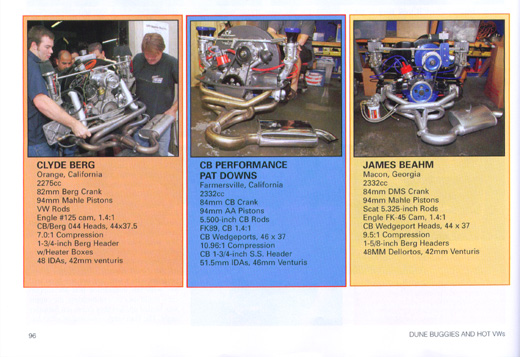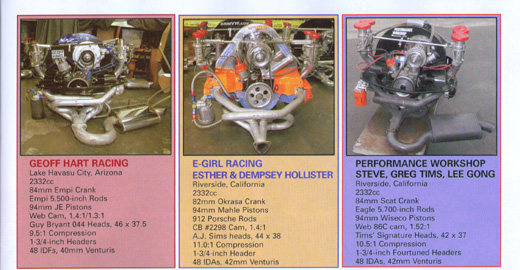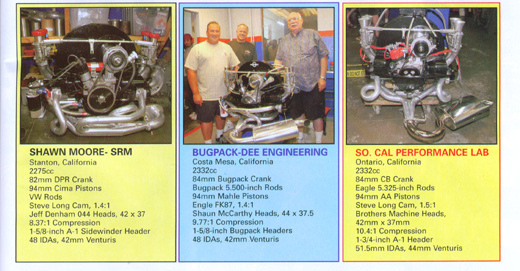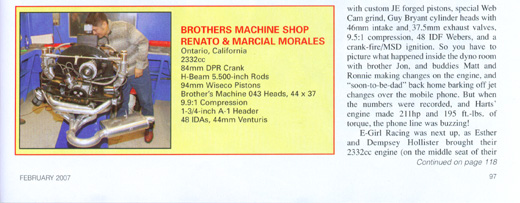Hot VW's - February 2007 - VW Engine Builder Showdown
VW
Engine Builder Showdown
BY DEAN KIRSTEN It was an idea that has been brewing around VW engine builder circles for years. A one-day dyno challenge to see who could make the more horsepower and torque. Plain and simple. But knowing that every engine builder would have his or her own ideas as to what limits should be placed on this engine challenge, someone had to step in and make sense of all the conflicts and confusion, and come up with a set of rules that would actually work. In stepped Anibal Chico of Chico Performance Racing in Monrovia, California - an up and coming VW engine builder who started to discuss this idea with guys like Jack Sacchette, Brother's Machine Shop, Performance Lab and many others. But while the idea was embraced by a number of VW tuners, things just couldn't seem to get off the ground and get going. Looking back at the past nine months, if it wasn't for the internet, specifically three of the more popular VW forums (Cal-Look.com, TheSamba.com, and ShopTalkForums.com), we seriously doubt if it would have ever come to pass. So, back in early summer, Chico announced to the VW world that on Sunday, October 15th, at JayCee Enterprises in Huntington Beach, California, there would be a one-day VW dyno showdown. The rules were announced, and posted to all potential engine builders (see sidebar for rules), so they could get started on their engine entries well in advance. The rules outlines a high performance "street" engine (although the word "street" was never actually used) that had to run on 91 octane pump gas, use all the cooling tin, fan, alternator/generator, be normally aspirated, with a size limit of 2332cc, Carburetor's size was limited to 52mm, and a muffler was mandatory. EFI, superchargers, nitrous oxide, and turbos were not allowed. The use of aftermarket cylinder head castings was also prohibited, as was relocated valve guides (centerlines). The main idea of this challenge was to show up with a complete engine, ready to run, that could be hooked up to the dyno in a matter of minutes. Time was of the essence as, according to the rules, once the engine was ready to fire and the starter button pushed for the first time, there would be a 35-minute limit for that particular engine. During that time, it was possible to make sever dyno "pulls" to check jetting or timing, but as the clock drew closer to the end of the session, it was time to make the final RPM runs. According to the rules, power readings would be taken at 3,500, 4,500, and 6,500 RPM, and from those numbers maximum horsepower and torque were to be extracted. In most cases, the peak horsepower was recorded at 6,500, while peak torque was often at 5,500 RPM. Once the final pulls were taken, the engine was then removed from the dyno to make room for the next contestant - but it all had to happen within one day (albeit a rather long one). The actual readings taken during this eight-hour session would be straight off the dyno without any correction factor given for weather conditions, hence the reason this dyno session had to be run during one day only, rather than two or more. The dyno at JayCee Enterprises is an industry standard Stuska, which is a water brake "flywheel" dyno, able to read up to about 400 hp. But knowing his dyno better than anyone else, Jack Sacchette has learned to "add 4" (dyno) pounds to every reading to match that of other dynos within the VW industry. Dyno readings taken from these tests would be multiplied by the rpm to equal horsepower. That same dyno reading was then multiplied by 5.252 for the torque reading. Once the basic perimeters of the challenge were drawn up and posted, word quickly circulated among the VW industry, and the serious players began to throw in their hats to enter this unique horsepower contest. Early on, it was hoped that there would be somewhere around 5-8 builders participating in the challenge, but with the test some months away, no once could be sure who would actually show up. As the big day drew closer, more and more engine builders began to confirm their entry. One in particular was James Beahm, who drove all the way from Macon, Georgie with his engine loaded onto the back seat of his late model Golf! Now, this guy was serious! Saturday, the day before the big dyno challenge, many of the engine builders began to show up at JayCee Enterprises to drop off their engines and get a lok at the dyno setup - not to mention size up the other engines. During that afternoon, several entry engines were pre-run on Jack's dyno to establish baseline figures, and get an idea of jetting for the next day. Unfortunately, three of these engines ran into problems that required significant amounts of work to get them back into action, which in some cases went into the wee hours of the night and early morning. Those engines belonging to Brothers Machine, So Cal Performance Lab, and CB Performance went back onto the engine stands for a time, but luckily, in all three cases, they finished up their work in time for Sunday's big test. Early Sunday morning, JayCee Enterprises' shop quickly became a hotbed of excitement. Since this event was open to the public, Chico Performance and JayCee both chipped in and supplied plenty of drinks (nearly 1,200, thanks to Corrie Sacchette's 7-Up connection), burgers, and hot dogs for everyone to enjoy throughout the day, cooked-up by Chico's brother, Jose. Later on, a huge delivery was made by the local Pat & Oscars, which included chicken, salads, bread sticks, and pizza. Man, what a feast! Most spectators came to see all the engines, and hear them roar on the dyno. But limited space in and around the dyno room prevented only but handful being close to where the action was. But Chico came to their rescue with a huge flat screen monitor placed at the back door, so everyone in the back alley could see a close-circuit picture of the engines on the dyno. Great idea. At 10:00 a.m. the dyno session began, and the first task on the list was to establish an order to which each engine builder would use the dyno. With eight engine would use the dyno. With eight engine builders present, names were drawn out of a hat; Clyde Berg, Esther (aka E-Girl) and hubby Dempset Hollister, Pat with CB Performance, Shawn Moore (SRM), James Beahm, Steve and Greg Tims (Performance Workshop), Geoff Hart (Geoff Hart Racing Engines), and Bugpack Performance Products (Gary Fulton, Rick Sadler, and Bill Taylor). Two others were still back in their shops working on their engines - So Cal Performance Lab and Brothers Machine Shop - so they were given the last #9 and #10 spots, allowing them every possible minute to join in the dyno session. As the names were announced by emcee "Dyno Don" Chamberlain, Clyde Berg was #1 on the roster, and the VW Engine Builder Showdown was off and running! Clyde Berg's engine looked very different from the rest, in that his 2275cc entry was fitted with a 1-3/4-inch header, full heater boxes, and fresh-air fan housing. Not only did he use 48 IDA's (like the majority of the engines), he also had stock fuel pump, air cleaners, and relied on only a 7.0:1 compression ratio - by far the lowest of the entire field. After his thirty-five minute time on the dyno was up, his best numbers were 172hp @ 6,500rpm, and 162 ft.-lbs. of torque @ 5,500. (This engine was later installed into his chop-top racer and run at Fontana, where it took Berg to the finals in Pro Eliminator, running low 12's in the quarte mile). The second engine to go on the dyno was built by Pat, who heads up the engine department at CB Performance. This 2332 featured CB crank and rods, gas ported AA pistons, a stout 10.97:1 CR, 51.5mm IDA's , Wedge Ports , with titanium valves and CB's LS-1 spring package. And, like all engines run this day, it had a full fan shroud, doghouse cooler, and a muffler. Pat, with help from Alex Jimenez, made a few jetting changes during his 35-minute period. When the final numbers were read, CB's engine raised the bar considerably to 224hp @ 6,500, and 189 ft.-lbs. of torque. Those would prove to be tough numbers to beat as this day progressed. Engine #3 came all the way from Macon, Georgia, and was built by James Beahm (aka James 2). Now, everyone who was there that day really had a lot of respect for James, driving all the way to California to show his stuff. Appearance-wise, his 2332cc engine looked slightly different in that he used a Jake Raby DTM fan housing, and dual 48 DRLA Dellorto carburetors with air cleaners. Inside, James' engine featured an Engle FK45 cam. Steve Sands cylinder heads with 9.5:1 compression and 1-5/8-inch headers. But as they say, the proof is in the pudding, and once his jetting and timing were dialed in, this long-distance traveler twisted the dyno to an impressive 201hp and 184 ft.-lbs. of torque. Fourth in line was the Geoff Hart Racing team from Lake Havasu City, Arizone, comprised of Jon Hart, Matt Adragna, and Ronnie (Old Volks) Feitelson. But what everyone wanted to know was, where was Geoff? Well, with a new baby due at almost any minute, the family decided that Geoff needed to be by his (very) pregnant wife's side, and not at a dyno test! So, with full confidence that his support crew could take care of business, the engine was loaded up, and they drove out Saturday night. The Hart entry consisted of a 2332cc, with custom JE forged pistons, special Web Cam grind, Guy Bryant cylinder heads with 46mm intake and 37.5mm exhaust valves. 9.5:1 compression, 48 IDF Webers, and a crank-fire/MSD ignition. So you have to picture what happened inside the dyno room with brother Jon, and buddies Matt and Ronnie making changes on the engine, and "soon-to-be-dad" back home barking off jet changes over the mobile phone. But when the numbers were recorded, and Harts' engine made 211hp and 195 ft-lbs. of torque, the phone line was buzzing! E-Girl Racing was next up, as Esther and Dempsey Hollister brought their 2332cc engine (on the middle seat of their minivan) to join the challenge. This engine consisted of a vintage 84mm Okrasa crank, Porsche 912 rods, A.J. Sims 44mm x 38mm valved heads set at 11.0:1 compression, IDA's with 42mm chokes, and a CB 2298 cam. With last minute help from Greg at Vee Dub Parts Unlimited and Steve Tims, they were able to get their engine together in the nick of time. Technically, their engine was not exactly up to the rules, in that they did not have all the necessary sheet metal, or a doghouse cooler. But no one seemed to mind . . . this time. After the normal warm up period, E-Girl's 2332cc powered up to 188hp with 170 ft-lbs. of torque. Another engine entry from the Riverside, California area was up next, the team of Greg and Steve Tims of Performance Workshop. Their entry was actually the engine out of Lee Gong's street car, but since the original rules stated that readings would be taken at 3,500 and up, they decided to make some changes to the came and compression. So, the day of the dyno test, they showed up with a 2332cc, fitted with a (smaller) Web 86C cam, IDA's with 42mm venturis, and (lower) 10.5:1 compression, and of course, Steve Tims Signature cylinder heads. But once they saw that dyno runs were rarely taken at 3,500, and were no longer mandatory, they were more than upset about the change. But, with no time to make any kind of changes to their internal combination, the engine was installed on the dyno and made ready for the test. As the Tims/Gong engine was being warmed-up, a few onlookers made comment about how loose the fan belt was, knowing that it could be a way to save a few extra horsepower by spinning the fan slower. And after a bit of "heated" discussions, the belt was tightened slightly, and (most) everyone was now happy. Final output numbers for the Tims/Gong engine were an impressive 14hp and 183 ft-lbs. of torque. We should note that this engine really sounded smooth as it pulled through the rpm range. (A few weeks after this test, Lee's engine was re-installed into his 1,720-pound sedan and ran 11.90 @ 108 MPH . . . on pump gas). Engine #7 was next, and this 2275cc was built by Shawn Moore of srmvw.com in Stanton, California. Shawn assembled his engine with a DPR crank, VW rods, a special Steve Long cam, and a pair of Jeff Denham 42mm x 37mm heads with only 8.37:1 compression. His exhaust was an 1-5/8-inch Sidewinder from A-1 Muffler, and carburetors were IDA's with 42mm venturis. Shawn's engine ran up to 195hp @ 6,500 RPM, and peak torque was 173 ft.-lbs. Impressive numbers for a relatively low compression engine. And then came the over-the-hill gang from Bugpack! Now, all kidding aside, the big three from Dee Engineering - Gary Fulton, Rick Sadler, and Bill Taylor - got together and decided to build an engine in-house, using mostly Bugpack parts, and entered this challenge. Their 2332cc engine used a Bugpack 84mm crank, 5.500-inch rods, 1.4 rocker arms, 1-5/8-inch headers, and head castings, but had Shaun McCarthy port and polish the heads. Compression was set at 9.97:1, and IDAs were fitted with 40mm chokes. Once the test began, the team quickly decided that since 3,500 rpm readings were no longer an issue, that larger 42mm venturis would be best suited for this contest. So during their 35-minute setup, the guys quickly changed venturis, and then ran the engine as is. The result was a 211hp reading at 6,500rpm, and best torque was at 181 ft.-lbs. We can tell you that these guys were more than happy with those numbers! As the Bugpack engine was being removed off the dyno, it was about 3:20 in the afternoon. And unless the engines from Performance Lab or Brothers Machine showed up, the contest was over. But as fate would have it, both engines showed up in the nick of time, giving a full field of ten entries. Judging from the look of these guys, they probably had been up for most of the night rebuilding their engines for today's test. Engine #9 came from the So Cal Performance Lab in nearby Ontario, California. Headed up by Victor Menjivar and Shag Leon, with help from Mike, Shahim, and Jason, their 2332cc engine used a CB crank, 94mm AA pistons, custom Steve Long cam, Brothers Machine cylinder heads with 10.4:1 compression, and 51.5mm carburetors with 44mm venturis. With time quickly running out, they had to hustle to get this engine up and running smoothly. For their efforts, the best reading turned out to be 195hp and 176 ft.-lbs. or torque. The final engine of the day went on the dyno at about five in the afternoon. The engine from Brothers Machine, also from Ontario, was placed on Jack's dyno by Renato and Marcial Morales. This 2332cc engine had a DPR crank, 5.500-inch rods and 94mm Wiseco pistons. Cylinder heads were done in-house, with 9.9:1 compression, cam was a custom grind from Web, and IDAs used 44mm venturis. The last pull of the event shows the Brothers' engine to make a best of 24hp, and 181 ft.-lbs. or torque. As things began to wrap-up, the numbers revealed that all the late night wrenching on his engine paid off, as Pat with CB Performance was tops in both horsepower and torque with a very impressive 224-horsepower and 189 ft.-lbs. Best Appearing Engine was awarded to the Bugpack boy's 2332cc, and the "Better Luck Next Time" so-called honors went to Clyde Berg. For a first time event, the VW Engine Builder Showdown turned out to be a very interesting, and most exciting one-day throw-down of who can make the most power under strict guidelines. Certainly there is room for improvement, with more clarity in how the test should be run. Rules will be modified before next year's event takes place, you can bet on that. One of the most important changes would be to prohibit contestants from using the host dyno one week prior to the dyno day. Other rules about mandatory rpm range, fans, belt tension, will no doubt be addressed in the weeks and months to come. Sponsors of this awesome event include: Chico Performance Racing, JayCee Enterprises, Vee Dub Parts Unlimited, DPR Machine, BMD Pulleys, AA Automotive Products, Quality German Auto Parts, Brothers Machine, CB Performance, Bugpack, Scat, Jake Raby, So Cal. Performance Lab, and Chico Towing. |
